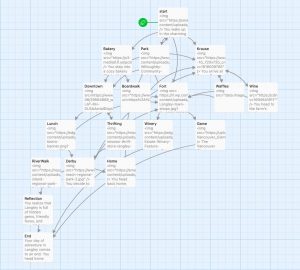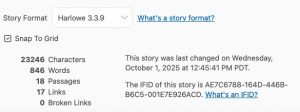Link #1 – What’s in your bag? (Task 1) – Erica Houston
I chose to link Erica’s post because it really resonated with me. She describes the items in her bag as a “portable biography,” which illustrates the many roles she plays in her life. As a new mom, this idea resonated with me because I also juggle various roles, and I hadn’t realized how the contents of my bag could visually reflect those roles. Erica’s point about her bag representing values was also fascinating to me. I hadn’t thought about that aspect before. It made me reflect on my own bag, a small Lululemon crossbody, which can only hold fewer and smaller items and, by extension, may only reflect a small part of my values or personality. Interestingly, Erica also mentions carrying this same Lululemon bag inside her larger bag.
Both of us used WordPress through UBC Blogs for our posts, but the visual presentation is quite different. Erica’s background and overall look differ from mine, which highlights how the same authoring platform can produce personalized results based on individual choices. In terms of theoretical underpinnings, Erica’s post subtly reflects ideas of identity construction and personal narrative, which influence how she presents her “biography” through objects.
Link #2 – Does language shape the way we think? (Task 2) – Michael Cafuta
In reflecting on Michael’s post, I decided to link to his work because it provides a great example of effective textual architecture that emphasizes conciseness and personal storytelling. His concise, focused writing style seems designed to engage readers by relating to their experiences. I noticed that his post is organized in a way that prioritizes clarity and readability, which somewhat differs from my own approach, which tends to be more wordy.
One thing I noticed is that I also try to include personal stories and experiences in my own writing for this course, so I appreciated how well Michael did this. It made his points more relatable and engaging. I especially enjoyed reading about how the culture in Japan affects the way language is used there. The specific examples he shared helped me understand this idea better, and it made the topic feel more real and concrete. His approach showed me how sharing real-world examples can make writing more vivid and meaningful. Overall, reading his post gave me ideas for how I can make my own writing more personal and clear.
Link #3 – Twine (Task 5) – Johnathan Duek
At first, I found it challenging to choose a fellow student’s Twine task to link because most of the hyperlinks to the Twine games others created were not working for me. After some time, I figured out a way to download the games. It turned out my computer was blocking the downloads because the files were labelled as “unsafe”. This experience shows that adding hyperlinks and downloadable files to written communication adds new complexities to consider when developing content and improving the reader experience. In the end, I decided to link Jonathan’s task and the game he created called “Another Morning”. His game was easier to access since it was hosted on a different website (itch.io). I appreciated this approach because it offered better accessibility from a reader’s perspective.
Our approach to building the actual game was similar. In both games, players have the option to choose the next step in their journey by clicking on the hyperlink option they wish to proceed with. I find this very engaging as the player is empowered to make their own decisions about how to engage with the game. Some differences between our games include the use of visuals and the inclusion of a progress percentage. While I included images in my game, the “Another Morning” game relied on written communication. One aspect I found engaging in this game was how a “preparedness” percentage was included, which tracks how much progress you are making as you play the game. I found this to be an excellent addition that provides meaningful information to players.
Link #4 – An emoji story (Task 6) – BL
It was interesting to see how others approached this task and how they selected and organized their emojis to represent the chosen movie/TV show. I decided to link BL’s work because her approach was significantly different than mine. While I relied on the ideas the emojis represented, BL primarily focused on the words they represented. Additionally, she added symbols (i.e. +, X) to describe the connections between emojis, which I did not consider. Her approach was more detailed and intricate, using a greater number of emojis and combining them with symbols to effectively convey the movie/TV show title/plot. This comparison helped me see alternative ways to enhance clarity and depth in visual storytelling.
I tried to think which TV show or movie the emojis’ story represented, but unfortunately, I am not confident in any of my guesses. This exercise made me consider the limitations of relying on only a single mode of representation. In this case, having additional modes of representation would have been helpful in effectively conveying the media being referenced. This ultimately reinforces for me the value of multimodal communication.
Link #5 – Mode Bending (Task 7) – Momina Abid
I chose Momina’s task because her approach was creative and outside the box. She designed a game using a tool called Makecode Arcade, which replicates the look and feel of an arcade game. I was unfamiliar with this tool, so I am grateful to have been introduced to it. Her approach encourages me to think more creatively when working on my own projects. Another aspect I enjoyed of her redesign of the “What’s in your bag?” was that she not only included items in her bag but also indicated why they were included. For example, when she shared that she had hand cream in the bag, she also explained that it was there because her hands get really dry. Including this information made the game more relatable and engaging for me. This reflection shows how combining creativity with thoughtful context can make communication both enjoyable and meaningful.
Link #6 – Speculative Futures (Task 12) – Angela Jarvis
This was one of my favourite tasks in the course. I was fascinated by the potential futures we explored. While my scenario painted a bleak picture of humanity’s relentless pursuit of efficiency, Angela’s presented an optimistic vision that restored my faith in technology’s ability to inspire positive societal change.
Both scenarios highlight the tension between innovation and ethical stewardship. While my story warns of potential dehumanization, Angela’s inspires a commitment to collective responsibility. Personally, I would like to imagine a future that leverages progress and honours humanity and nature.
We both used Microsoft Copilot to generate our scenarios with different prompts. Additionally, we hosted our posts on WordPress within UBC Blogs. That said, the templates for our posts are slightly different, resulting in different colours and visuals. In my post, I also added an image to help immerse readers in the scenario. I would have liked to see an image that represents Angela’s scenario, as I believe it would have captivated the audience even more. Ultimately, I think we took a similar approach when completing this task.





